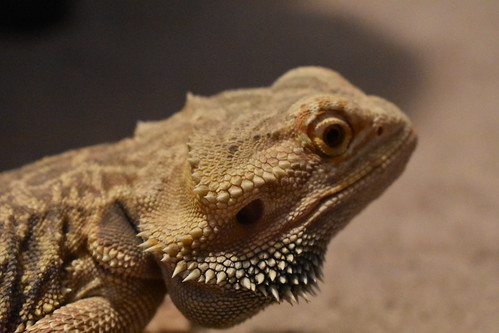Yes, ceramic tiles can be used as a substrate in a bearded dragon cage. In fact, ceramic tiles are a popular choice among bearded dragon owners because they are easy to clean and maintain.
Ceramic tiles come in a variety of textures and colors, including sand color, which can blend well with the dragon’s habitat.
To use ceramic tiles as a substrate, start by laying a layer of paper towel or newspaper on the base of the enclosure floor and place the tiles on top of it.
It is recommended to use smaller tiles and grout them to ensure a secure fit. Using ceramic tiles as a substrate has several advantages over other materials. They are easy to clean, which saves time and energy.
Advantages of Using Ceramic Tile in Bearded Dragon Cages
Using ceramic tile as a substrate in bearded dragon cages offers several advantages. Here are the benefits of using ceramic tile:
- Non-porous and Hygienic: Ceramic tiles are non-porous, which means they do not absorb moisture or odors. This makes them easier to clean and disinfect, promoting a hygienic environment for your bearded dragon.
- Low Maintenance: Once ceramic tiles are in place, they require minimal maintenance. Cleaning is quick and easy, saving you time and energy in maintaining the ideal habitat for your reptile pet.
- Reduced Risk of Impaction: Bearded dragons tend to scoop up substrate when catching their prey. Using materials like sand, clay, or small pebbles can accidentally be ingested and lead to impaction. Ceramic tiles eliminate this risk, providing a safe substrate option.
- Visually Appealing: Ceramic tiles come in a wide variety of textures and colors, allowing you to create an aesthetically pleasing enclosure for your bearded dragon.
- Affordable and Durable: Ceramic tiles are an affordable substrate option that offers long-term value for money. They are durable and can withstand the activities of your bearded dragon without needing regular replacement.
It is important to note that ceramic tiles can be slippery, so it is recommended to provide some texture or grip to prevent your bearded dragon from slipping.
Additionally, be cautious of the temperatures inside the enclosure as ceramic tiles can retain heat, which may require additional temperature regulation.
Overall, using ceramic tile as a substrate in bearded dragon cages provides a practical, hygienic, and visually appealing option that promotes the well-being of your pet.
Potential Concerns with Using Ceramic Tile in Bearded Dragon Cages
Using ceramic tile as a substrate in bearded dragon cages has some potential concerns that should be considered. Here are some pros and cons of using ceramic tile in bearded dragon cages based on the search results:
Pros:
- Affordable: Ceramic tiles are an affordable substrate solution that doesn’t need regular replacement.
- Low maintenance: Many bearded dragon owners choose tile because it is low maintenance. Once the tiles are in place, cleaning is quick and easy, saving you valuable time and energy when it comes to providing the ideal habitat for your reptile pet.
- Durable: Ceramic tiles are durable and can last a long time.
Cons:
- Retains heat: Ceramic tiles retain heat, which can increase temperatures inside the habitat. This can be dangerous for bearded dragons, as they require a specific temperature range to thrive.
- Slippery: Ceramic tiles can be slippery, which can cause issues for bearded dragons that need a good grip to move around.
- Can break: Ceramic tiles can break, which can create sharp edges that can harm bearded dragons.
- Not natural: Ceramic tiles are not a natural substrate for bearded dragons, and some owners prefer to use natural substrates to create a more natural environment for their pets.
In conclusion, while ceramic tiles have some benefits as a substrate for bearded dragon cages, there are also some potential concerns that should be taken into account before using them. It is important to consider the specific needs of your bearded dragon and consult with a veterinarian or other expert before making a decision about the substrate.
Preparing Ceramic Tiles To Use in Bearded Dragon Cages
Ceramic tiles are a popular choice for bearded dragon owners as they are affordable, low maintenance, and do not need regular replacement.
They come in a wide variety of textures and colors, including sand color, which can blend into your dragon’s habitat with confidence.
Ceramic tiles are non-porous and resistant to moisture, making them a good choice for bearded dragon tanks.
However, they can be quite slippery, so it is important to provide a barrier between the tiles and the glass in case a tile slips. Here are some steps to prepare ceramic tiles for use in a bearded dragon cage:
- Cut a piece of plywood to fit the enclosure and tile it like you would tile any floor but on a much smaller scale. You will want to buy smaller tiles, and you will need to grout them.
- Once you have your bearded dragon tile floor installed, place a layer of play sand (1/4″ to 1/2″ thick) under the tiles to provide a barrier between the tiles and the glass in case a tile slips.
- Spot clean the tiles daily and use reptile disinfectant if necessary in areas where you pick up poop. Do a thorough cleaning of the tiles once a month
Tips for Maintaining Ceramic Tile in Bearded Dragon Cages
Maintaining ceramic tile in bearded dragon cages is a low-maintenance option that provides a safe substrate for your pet. Here are some tips for maintaining ceramic tile in bearded dragon cages:
- Spot clean daily: Remove any feces or uneaten food from the tile daily.
- Weekly deep clean: Once a week, remove all the tiles and soak them in a disinfectant solution.
- Protect the tank’s floor: Be careful when putting the tile in your bearded dragon’s tank, as it can scrape or break the terrarium floor, especially if it’s glass. Using a thin towel or newspaper between the floor and the tile can help protect the tank’s floor.
- Avoid harsh chemicals: Use a safe, low-odor cleaner to spot-clean the tile daily. Avoid using harsh chemicals that can harm your bearded dragon.
- Monitor temperature: Ceramic tiles retain heat, which can increase temperatures inside the habitat. Monitor the temperature inside the enclosure and adjust accordingly.
By following these tips, you can maintain a safe and clean environment for your bearded dragon using ceramic tile as a substrate.
Conclusion: Is Ceramic Tile a Good Choice for Your Bearded Dragon Cage?
After considering the advantages and potential concerns of using ceramic tile in a bearded dragon cage, it is safe to say that it can be an excellent choice for pet owners. The durability, ease of cleaning, and heat retention properties make it a practical solution, while the aesthetic appeal adds to the overall look of your pet’s living space.
Summary of Advantages and Concerns Discussed
Ceramic tile offers several benefits when used in a bearded dragon cage, including its long-lasting nature, easy-to-clean surface, and heat-retention properties. However, there are some potential concerns that should be considered before making this choice.
Slippery surfaces may increase the risk of injury to your pet; it may not distribute heat evenly throughout the enclosure and comes with a higher initial cost than other materials.
Final Recommendation on Whether or Not to Use Ceramic Tile in Your Pet’s Enclosure
Based on our analysis of the pros and cons of using ceramic tiles in a bearded dragon cage, we recommend this material for those looking for durability and low maintenance.
However, if safety is your primary concern or you have budget constraints, alternative materials such as slate or paper towels could also suffice. Ultimately whatever material you pick should depend on your specific situation; better safe than sorry!



Leave a Reply